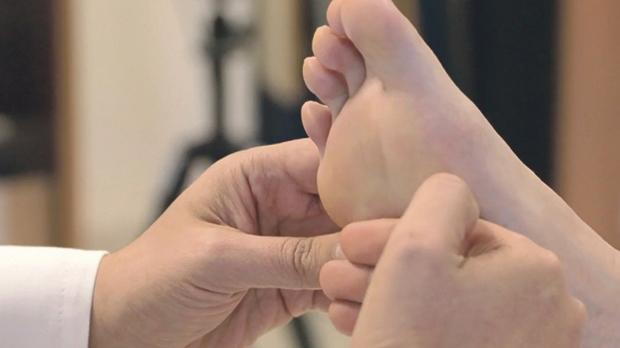
10th June 2018
Source : Times of Malta
According to the World Health Organisation, an estimated 422 million adults are living with diabetes worldwide, while in Malta, approximately 10 percent of the population are affected by the condition. Diabetes affects many areas of the body and is manifested with an increase in blood sugar levels.
Having diabetes increases the risk of developing a wide range of foot issues, often starting with a small foot problem that can turn into a serious complication, especially if left untreated. Around 15 to 20 percent of patients living with diabetes will develop a foot ulcer at some point during their lifetime. In Malta alone, each year around 400 individuals with diabetes loses part of their foot with huge implications to their quality of life. However, with proper and appropriate preventive measures, 85 percent of these foot ulcerations can be avoided. Foot temperature monitoring is a key player in the prevention of foot ulceration, as the foot heats up before it breaks down into a foot ulcer.
The heating up is due to an inflammatory process usually preceded by mild to moderate repetitive stress, most often witnessed between the foot and the shoe during daily activities. The purpose of skin temperature monitoring is for early detection of localized areas in the foot with an increase in temperature, so the patient and healthcare provider can take necessary actions to avoid any damage to the skin and possible ulceration risk.
The measurement of foot temperature is easy and can be performed in a clinic, but also by the patient at home. A simple physical examination of the foot, often performed by the healthcare provider, gives a subjective indication of temperature. Devices such as infrared thermometry provide a more objective alternative to examination methods. Medical thermography has gained popularity as an adjunctive diagnostic tool in the medical field, providing a dense, real-time skin temperature measurement.
However, a significant limitation with such devices is that the temperature can only be retrieved when the individual is stationary (e.g. laying on a bed) without shoes and socks. A novel wearable in-shoe temperature monitoring system is being proposed and developed. This portable system can be used during normal daily activities, and can drastically improve foot monitoring for the detection of any abnormal skin temperature patterns, by combining an array of temperature sensors with advanced data analysis techniques.
In the near future, this could improve ulcer detection at a very early stage, thereby enabling timely intervention, with a significant social and economic impact both for the individual and for the healthcare system.
The team, TARSOS, led by Dr Stephen Mizzi from the Department of Podiatry and Dr Owen Falzon from the Centre for Biomedical Cybernetics at the University of Malta, has been awarded funding from the MITA YouStartIT#3 accelerator programme to develop the proposed system.
Did you know?
• The earliest known written record that likely referred to diabetes was in 1,500BC in the Egyptian Ebers papyrus. It referred to the symptom of frequent urination.
• Diabetes symptoms such as thirst, weight loss, and excess urination were recognized for more than 1,200 years before the disease was named.
• The Greek physician Aretaeus (30-90CE) was credited with coming up with the name ‘diabetes’, meaning, ‘to pass through’.
• In ancient times, doctors would test for diabetes by tasting urine to see if it was sweet.
• Before 1921, the treatment of choice for type 2 diabetes was starvation or semi-starvation.
For more trivia see: www.um.edu.mt/think
Sound bites
• A Northwestern University team has developed a new treatment for diabetic foot complications. Called a ‘regenerative bandage’, the novel material heals diabetic wounds four times faster than a standard bandage and has the added benefit of promoting healing without side effects. The thermo-responsive material is applied to the wound bed as a liquid and solidifies into a gel when exposed to body temperature. When the same amount of the protein was directly applied all at once, no benefit was observed. This demonstrates the importance of slow release from the thermo-responsive material. It has been stated that the inherent antioxidant properties within the material also reduce oxidative stress to help the wound heal.
https://www.sciencedaily.com/releases/2016/08/160817101728.htm
• Scientists have discovered a molecule that forms part of the body’s tissue repair system, which could help treat non-healing wounds and injuries, such as a diabetic foot. A study led by the universities of Exeter and Bath, and published in the journal Antioxidants and Redox Signalling has made great strides in understanding how a particular molecule stimulates the formation of new blood vessels. The formation of new blood vessels is critical during the body’s response to tissue damage. This is a key target in regenerative medicine, and the team hopes that this discovery will provide a cost-effective treatment for manipulating blood vessel formation, especially in diabetes where new treatment strategies can help in avoiding such life-changing foot complications, and reduce medical costs for society.
https://www.eurekalert.org/pub_releases/2017-10/uoe-hmd100417.php
For more soundbites listen to Radio Mocha on Radju Malta every Saturday at 11.05am ( https://www.facebook.com/RadioMochaMalta/ ).
[/vc_column_text][/vc_column][/vc_row]

